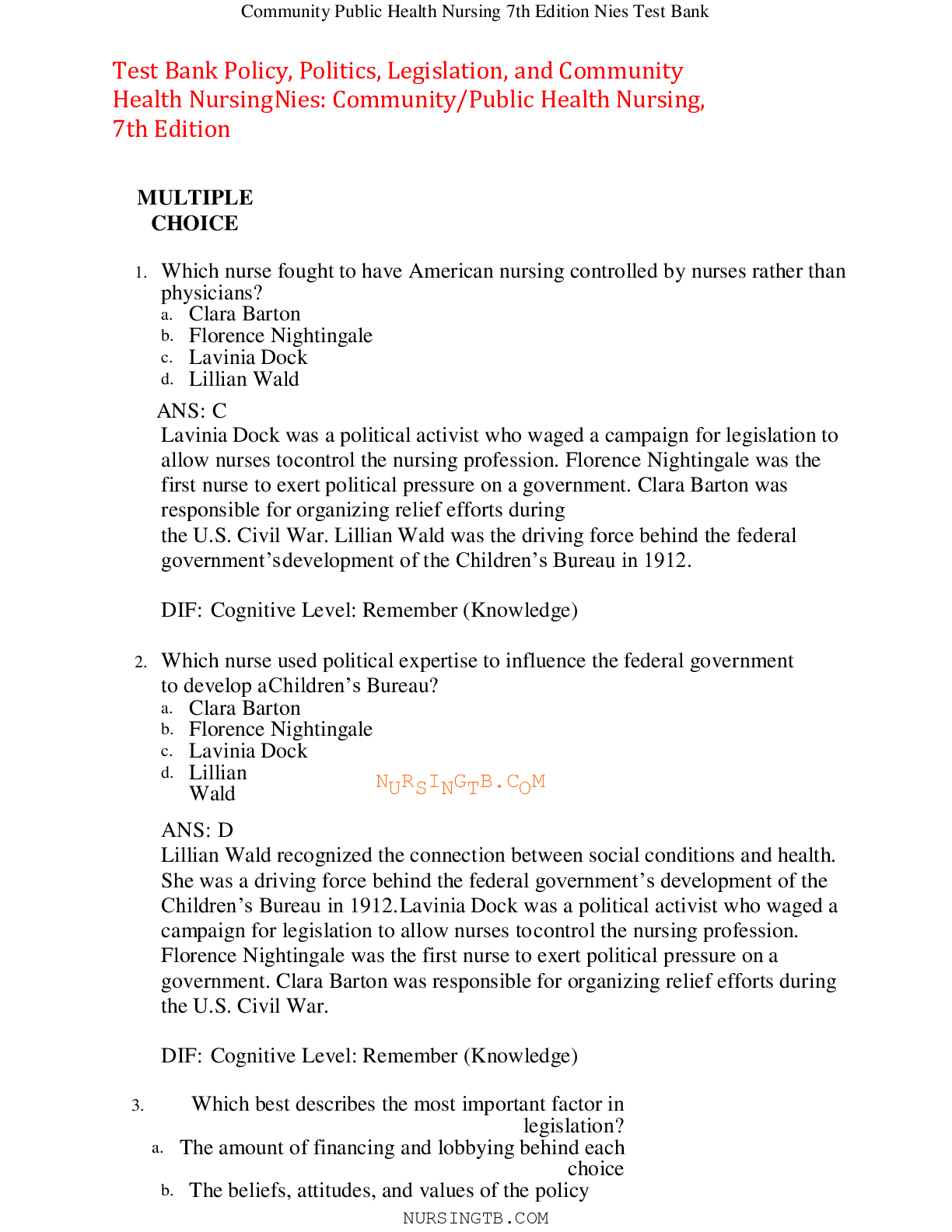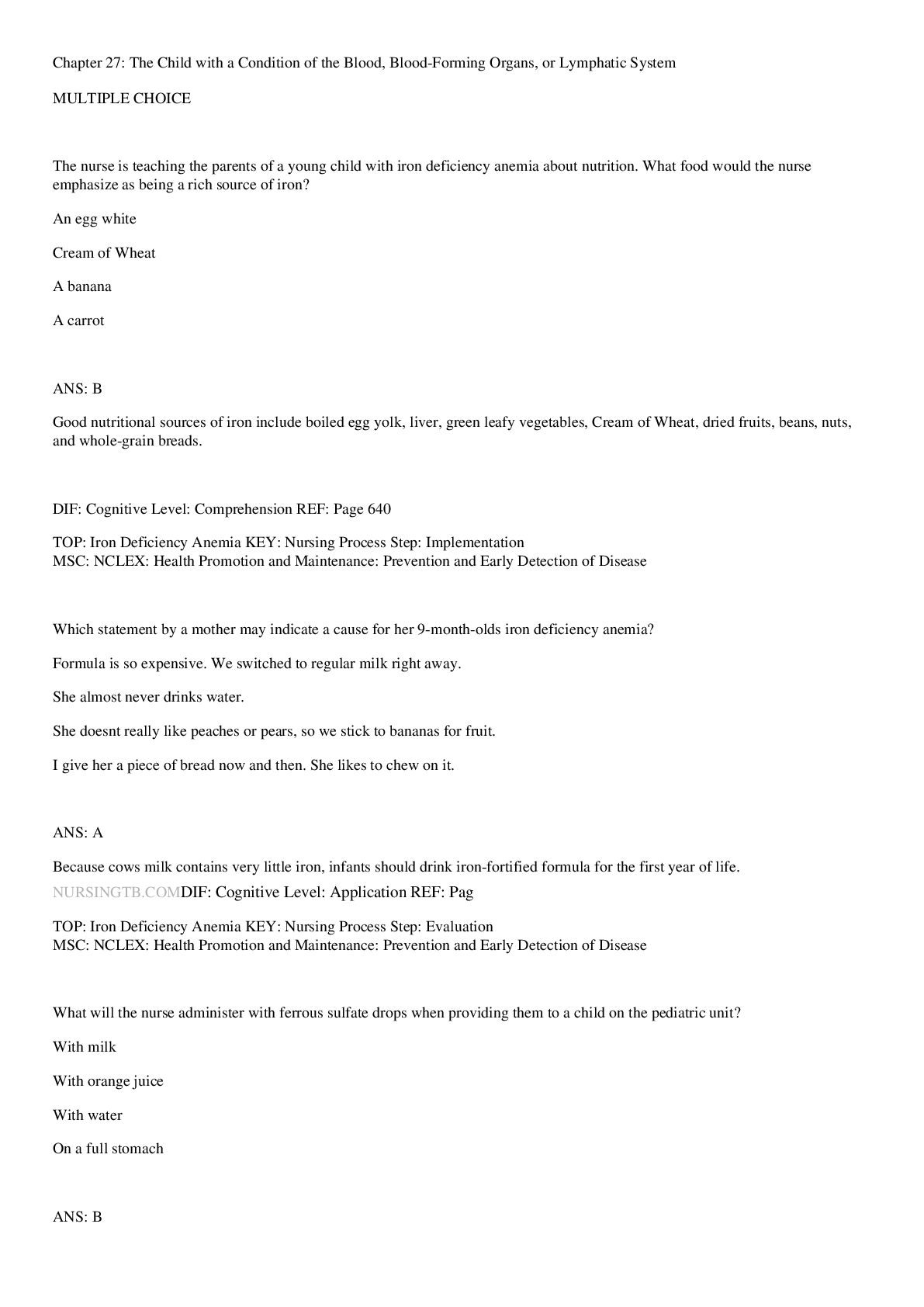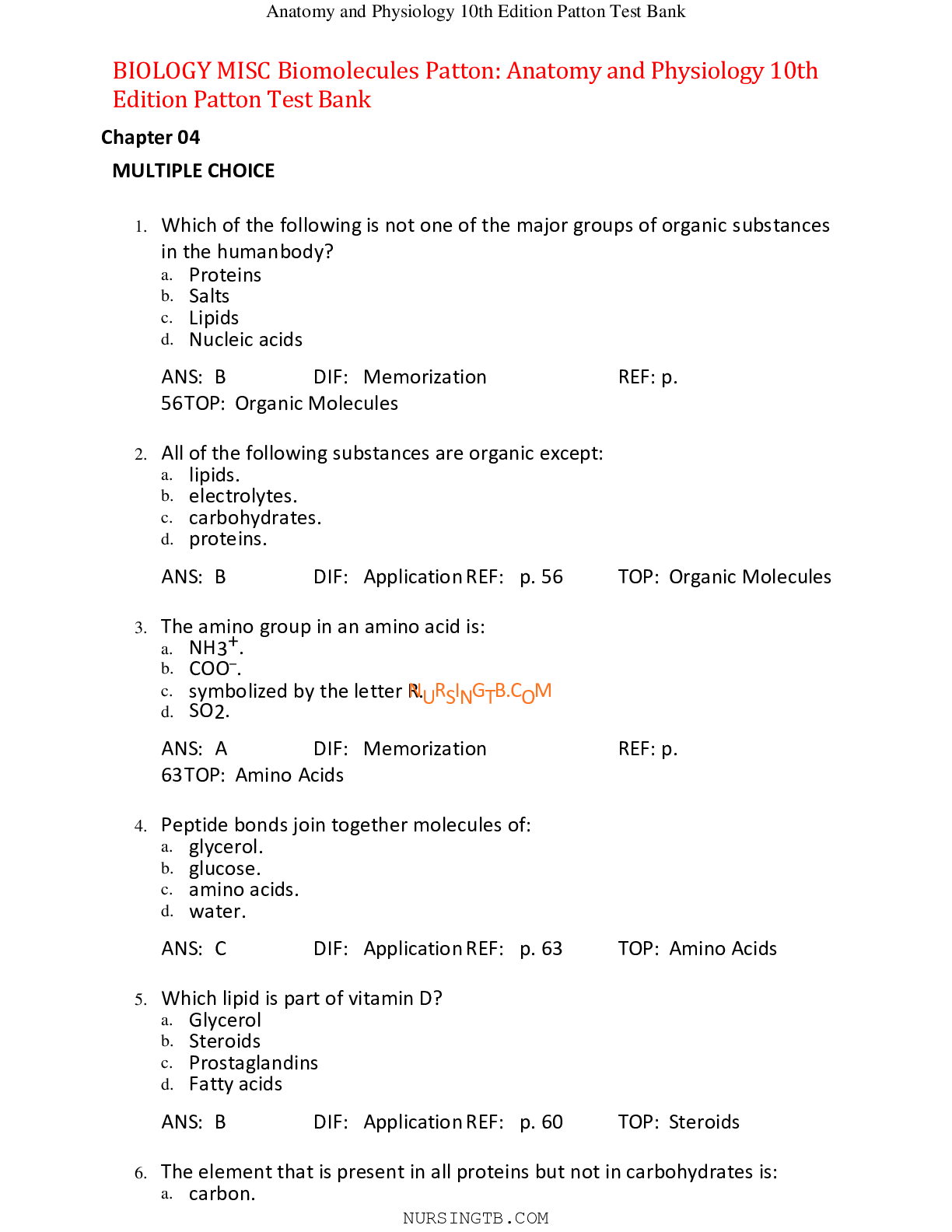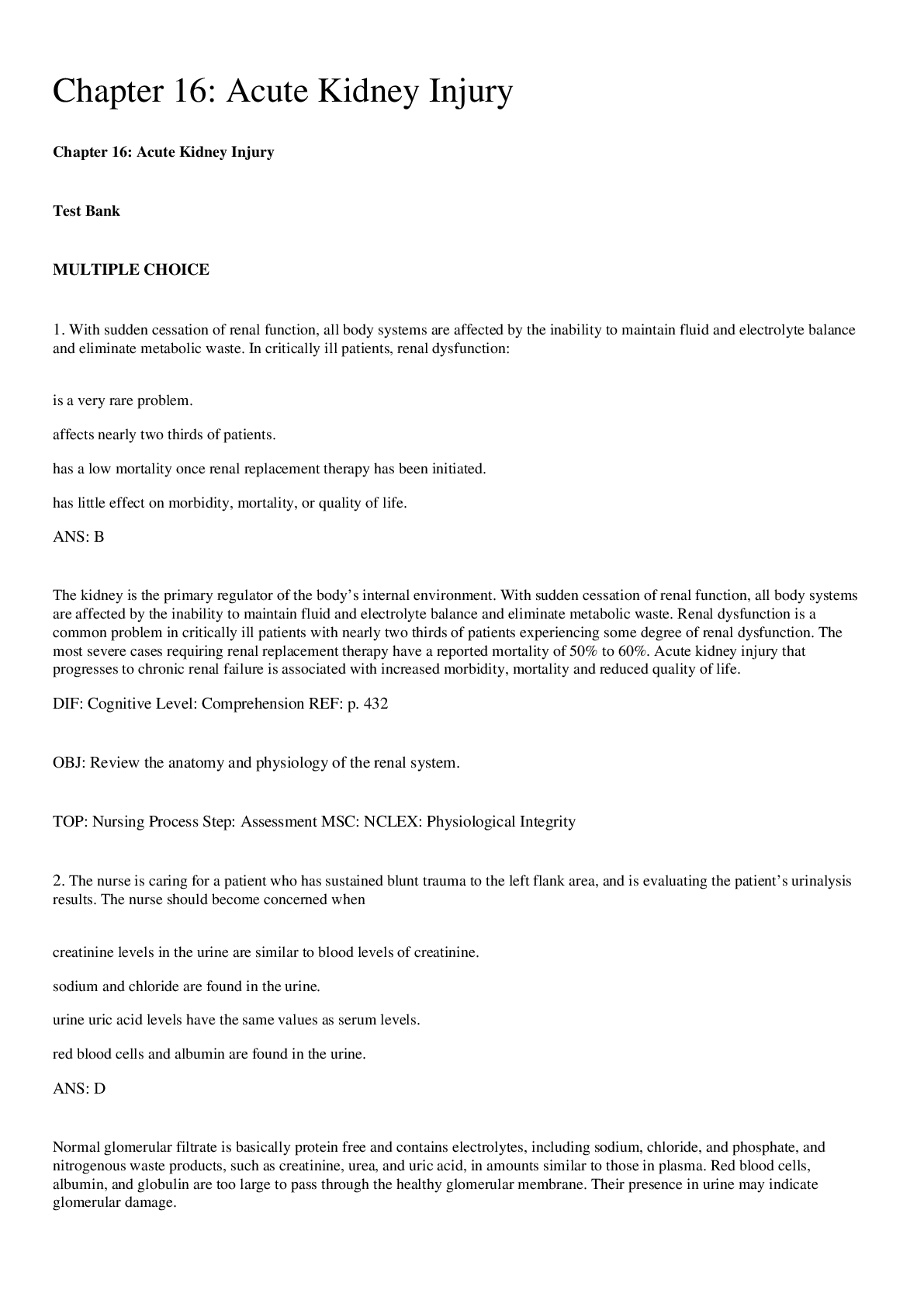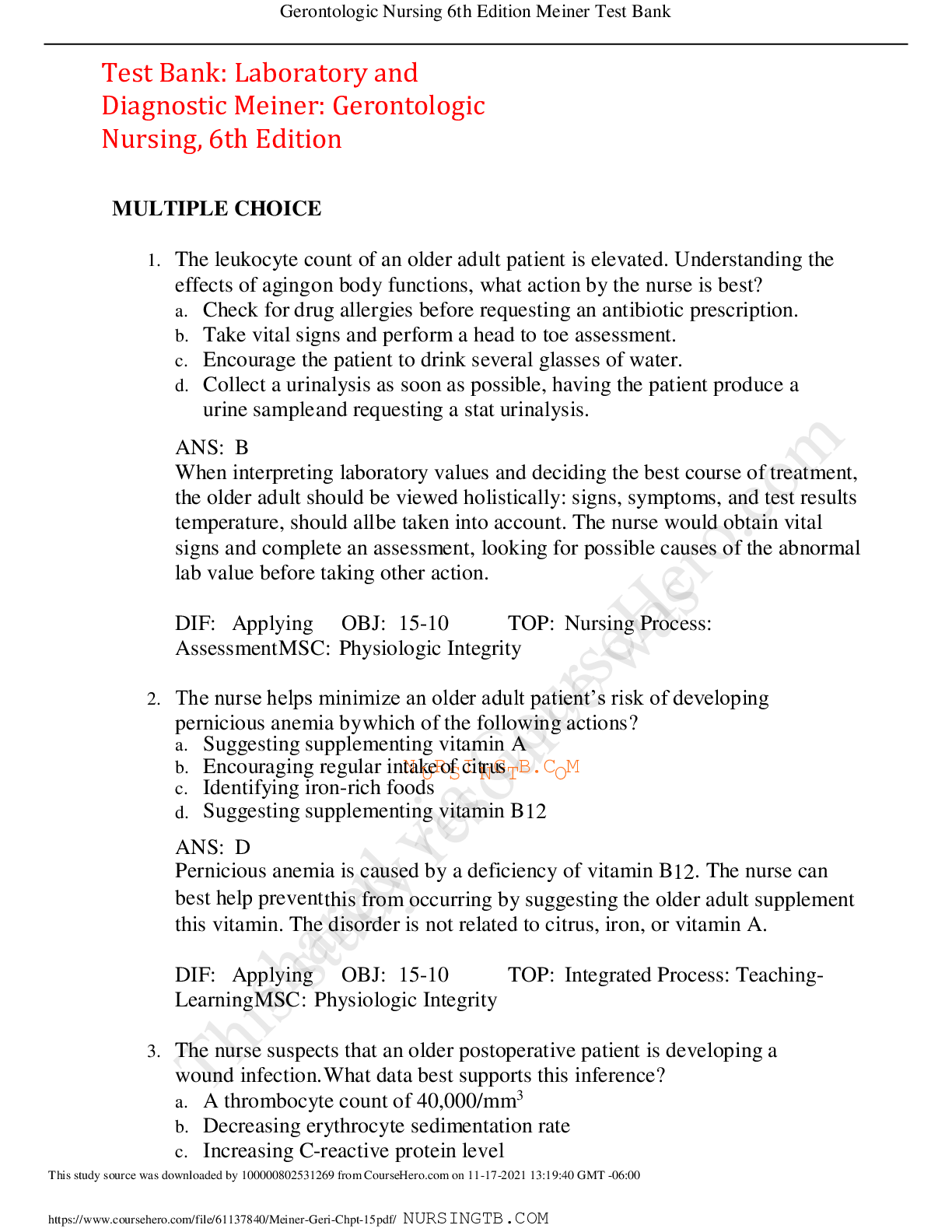*NURSING > TEST BANK > Test Bank: Drugs and Aging Meiner: Gerontologic Nursing, 6th Edition,100% CORRECT (All)
Test Bank: Drugs and Aging Meiner: Gerontologic Nursing, 6th Edition,100% CORRECT
Document Content and Description Below
Test Bank: Drugs and Aging Meiner: Gerontologic Nursing, 6th Edition MULTIPLE CHOICE 1. The nurse is preparing to apply a topical cream on the arm of a cognitively impaired, anorexic older adu... lt patient in the terminal stage of lung cancer. The nurse carefully monitors the effectiveness of the medication because its effectiveness will be most negatively impacted by the patient’s a. age. b. cognitive limitations. c. nutritional status. d. cancer diagnosis. ANS: A Reduction in subcutaneous fat associated with integumentary changes of aging alters topical drug absorption. These changes may result in impaired absorption of some drugs administered as lotions, creams, ointments, and patches. DIF: Remembering OBJ: 16-4 TOP: Nursing Process: Assessment MSC: Health Promotion and Maintenance 2. When administering medications to older adults, the nurse shows an understanding of the effect of aging on drug distribution by monitoring which of the following most closely? a. Cardiac function b. Liver function c. Red blood cell count d. Plasma albumin levels ANS: D NURSINGTB.COM With age, particularly for malnourished or frail adults, plasma albumin levels may drop and, therefore, should be monitored. As a result of decreased sites for protein binding, the activity of highly protein bound drugs, and any side effects caused by these drugs may be increased. The other options may be appropriate for specific drugs, but not in general. DIF: Remembering OBJ: 16-4 TOP: Nursing Process: Assessment MSC: Physiologic Integrity 3. An older adult patient has been prescribed warfarin. The nurse’s primary intervention involves daily assessment of which of the following? a. Prothrombin time b. Body for bruising c. Serum creatinine level d. Reflex tone ANS: A Warfarin therapy is monitored by the international normalized ratio (INR) or INR with prothrombin time. A patient receiving anticoagulants can have bleeding that leads to bruising, but this is not the priority. Creatinine and reflexes are not related. DIF: Remembering OBJ: 16-4 TOP: Nursing Process: Assessment MSC: Physiologic Integrity 4. A patient with diabetes and hypothyroidism is being admitted to an assisted living facility. During the admission assessment, the patient reports difficulty falling asleep. What question by the nurse is most appropriate? a. “Have you ever been prescribed a pain medication?” b. “How do you feel about leaving your home to live here?” c. “How long have you been a diabetic?” d. “Are you taking medication for your thyroid problem?” ANS: D Insomnia and anxiety are problems that commonly plague older adults. Because insomnia and anxiety often occur secondary to medication side effects or secondary to medical conditions such as dementia, thyroid abnormalities, or depression, proper diagnosis and treatment of any underlying causes of insomnia or anxiety can help this condition. The other questions are appropriate for an intake interview, but not specifically related to the insomnia. DIF: Understanding OBJ: 16-6 TOP: Nursing Process: Assessment MSC: Physiologic Integrity 5. A patient is receiving propranolol for hypertension. Which outcome demonstrates to the nurse that a priority goal related to medications has been met? a. The patient verbalizes the importance of moderate exercise. b. The patient experiencesNnoRinjuIriesGas Ba .reCsultMof dizziness. c. The patient’s blood pressure stays within normal limits. d. The patient describes symptoms indicative of an adverse drug reaction. ANS: B The main concerns with the use of antihypertensive medications in older adults are an increased risk of orthostatic hypotension and dehydration. Exercising and maintaining the blood pressure within normal limits are treatment goals but do not impact quality of life like dizziness or fainting. Having an adverse drug reaction would not improve quality of life. DIF: Evaluating OBJ: 16-6 TOP: Nursing Process: Evaluation MSC: Physiologic Integrity 6. An older adult diabetic patient is mildly hypertensive. The nurse prepares to educate the patient regarding angiotensin II–blocking agents. What information does the nurse include about these medications? a. Protect the kidney’s function. b. Have a well-defined therapeutic window. c. Are more effective than other drugs in the same class. d. Can be given when liver function is compromised. ANS: A The ACEIs and ARBs also have demonstrated value in decreasing the chance of cardiac mortality in patients with heart failure. They also confer renal protection, which is particularly beneficial for patients with diabetes. The other statements are not related to both the patient’s conditions. DIF: Applying OBJ: 16-6 TOP: Integrated Process: Teaching-Learning MSC: Physiologic Integrity 7. The nurse shows an understanding of medication-related risk factors common to older adults when asking which question? a. “Are you aware of the possible side effects of your medications?” b. “Do you regularly take any dietary supplements?” c. “How do you keep track of when your medications are due?” d. “How many different physicians are prescribing medications for you?” ANS: B About 52% of older adults living in the United States take some sort of dietary supplement on a regular basis in addition to prescription medications. This increases the potential for drug–drug interactions. The other questions are also important assessment questions to include in a medication review but do not specifically address risks of interactions between prescription medications and those prescribed. DIF: Understanding OBJ: 16-3 TOP: Nursing Process: Assessment MSC: Physiologic Integrity 8. The nurse is caring for an older adult who reports severe chronic pain. To best assess age-related physiologic chaNngeRs thIat cGouldBi.nfCluenMce plans for initiating an appropriate drug regimen, the nurse prepares the patient for which laboratory evaluation? a. White blood count b. Glomerular filtration rate c. Serum complement level d. Electroencephalogram ANS: B Many drugs are renally excreted, and there are age-related reductions in renal function. The nurse wanting to assess for such factors that influence the selection of drugs would most likely anticipate the patient having renal function studies done, including an evaluation of the patient’s glomerular filtration rate. DIF: Remembering OBJ: 16-4 TOP: Nursing Process: Assessment MSC: Physiologic Integrity 9. An older adult patient is being assessed for possible alcohol abuse. Which question by the nurse is best? a. “Have you ever experienced a memory loss as a result of consuming alcohol?” b. “Would you drink to relax after a particularly stressful day?” c. “Do you ever drink when you are alone?” d. “How many alcoholic drinks do you consume each week?” ANS: D The nurse should start the assessment for alcohol abuse by inquiring as to the number of drinks the patient consumes each week. The other questions can be part of an abuse assessment, but it is easiest to start with a simple, quantitative question to open the discussion. DIF: Applying OBJ: 16-10 TOP: Nursing Process: Assessment MSC: Psychosocial Integrity 10. An older adult patient is currently undergoing detoxification for alcohol at a rehabilitation center. When assessing the patient using the Clinical Institute Withdrawal Assessment tool, the nurse determines the patient’s current score to be 23. What action by the nurse is best? a. Immediately institutes seizure precautions. b. Monitors the patient’s vital signs every 2 hours. c. Arranges for the patient to be transferred to an acute care hospital. d. Shares with the patient that the detoxification process is almost complete. ANS: C The maximum score on this tool is 67, and patients who score higher than 20 should be admitted to a hospital. The nurse may need to institute seizure precautions, but for the ultimate safety of the patient, he or she needs to be transferred. Monitoring vital signs until the patient leaves is important. The detoxification process is not almost complete. DIF: Applying OBJ: 16-10 TOP: Nursing Process: Implementation MSC: Physiologic Integrity 11. A 78-year-old man with a history of alcohol abuse is admitted to the acute care facility for reports of abdominal pain. NBasRed oIn yGour Bun.dCerstManding of alcohol withdrawal, the nurse knows that if patient is currently abusing alcohol, he will most likely a. experience delirium tremors within 4 hours of hospitalization. b. develop withdrawal symptoms 48 to 72 hours after the last intake of alcohol. c. receive 1 ounce of alcohol every 4 hours while awake. d. be prescribed diazepam for prevention of withdrawals ANS: B Symptoms tend to peak 48 to 72 hours after a patient’s last drink, although they may occur within 4 to 12 hours. The patient may or may not have DTs. The patient should not receive alcohol and may or may not need medication. However, benzodiazepines are not recommended for use in this age group. DIF: Understanding OBJ: 16-11 TOP: Nursing Process: Assessment MSC: Physiologic Integrity 12. When working with a patient suspected of substance abuse, the nurse is particularly interested in determining the cause of a patient’s a. acute abdominal pain. b. recurring insomnia. c. extensive history of falls. d. chlordiazepoxide prescription. ANS: C Frequently, the symptoms of substance abuse are subtle or atypical, or they mimic symptoms of other age-related illnesses and remain undiagnosed. Patients’ presenting symptoms may be erratic changes in affect, mood, or behavior; malnutrition; bladder and bowel incontinence; gait disturbances; and recurring falls, burns, and head trauma. Acute abdominal pain, insomnia, and prescriptions for chlordiazepoxide may or may not be related to substance abuse, but falling is. DIF: Applying OBJ: 16-11 TOP: Nursing Process: Assessment MSC: Physiologic Integrity 13. Your patient reports frequent constipation as a result of prescription medications and asks the nurse for advice about using a daily over-the-counter laxative. The most appropriate response by the nurse is to do which of the following? a. Tell the patient to consult the health practitioner before using nonprescription drugs. b. Educate the patient about the side effects of regular laxative use. c. Tell the patient to avoid laxatives because they can interfere with medications already being taken. d. Tell the patient to consult a dietician about ways to correct chronic constipation. ANS: A Education regarding the importance of contacting the health practitioner (physician or pharmacist) before taking nonprescription medication is essential for reducing the number of unintentional medication interactions. Educating the patient on side effects and teaching the patient nonpharmaceutical ways to manage constipation are also appropriate. DIF: Understanding NURSINGTB.OCBOJ:M 16-8 TOP: Integrated Process: Teaching-Learning MSC: Physiologic Integrity 14. A newly-admitted older patient reports taking varenicline. What question by the nurse is most important? a. “How many packs of cigarettes did you smoke a day?” b. “How much alcohol do you typically drink each day?” c. “When was the last time you had your kidney function checked?” d. “Do you frequently lose your prescription medications?” ANS: A Varenicline is a drug that helps people stop smoking. The nurse would assess the patient’s smoking habits. DIF: Applying OBJ: 16-10 TOP: Nursing Process: Assessment MSC: Physiologic Integrity 15. The nurse explains to ancillary staff that caffeine abuse is difficult to diagnose in the older adult patient because caffeine intoxication symptoms a. can be confused with normal effects of aging. b. often mimic those of some cardiac disorders. c. produce fewer symptoms in older adults than in younger adults. d. resemble the side effects of several antihypertensive drugs. ANS: B Caffeine stimulates the sympathetic nervous system, often producing the rapid pulse associated with cardiac disorders. Caffeine effects are not mistaken for normal signs of aging, produce fewer symptoms in older adults, or resemble side effects of antihypertensives. DIF: Understanding OBJ: 16-10 TOP: Integrated Process: Teaching-Learning MSC: Physiologic Integrity 16. An older adult patient shares with the admitting nurse that she drinks “one shot” of whiskey nightly to help her sleep. What intervention does the nurse add to this patient’s care plan? a. Assess the patient for slurred speech, lack of coordination, and nystagmus. b. Address the effects of alcohol abuse with the patient. c. Provide the patient with an alcohol substitute. d. Assess the patient for signs of agitation, as well as anxiety and seizures. ANS: D It is important to assess older patients for the possibility of alcohol withdrawal if agitation, hallucinations, anxiety, or seizures develop. Because the patient admits to a shot a day, it is possible she drinks more or uses alcohol to self-medicate for problems other than insomnia. The nurse should monitor the patient for signs of withdrawal as a priority, because this is a medical emergency. Slurred speech, lack of coordination, and nystagmus are signs of overindulging. The nurse should not provide an alcohol substitute. It is appropriate to discuss the effects of alcohol, but safety comes first. DIF: Applying OBJ:NU1R6-S1I0 NGTB.TCOOPM: Nursing Process: Assessment MSC: Physiologic Integrity 17. The nurse is assessing patients for impending alcohol withdrawal. The nurse assesses the patient with which of the following conditions as a priority? a. Pulse, 58 beats/min; and BP 100/60 b. Pulse, 118 beats/min; and BP 160/90 c. Dozing off in chair and not recognizing staff d. Reporting muscle aches and frequent stumbling ANS: B Manifestations of alcohol withdrawal are elevated blood pressure, elevated pulse, and autonomic hyperactivity. In addition, fever; increased hand tremors; insomnia; nausea and vomiting; transient visual, tactile, or auditory hallucinations or illusions; psychomotor agitation; anxiety; and tonic-clonic seizures may occur. The nurse should see the hypertensive, tachycardic patient as the priority. DIF: Applying OBJ: 16-11 TOP: Nursing Process: Assessment MSC: Safe and Effective Care Environment MULTIPLE RESPONSE 1. To minimize the possible complications of polypharmacy among older adult patients, the nurse assesses this population for which of the following? (Select all that apply.) a. Number of physicians providing medical care b. Location of pharmacies where prescriptions are filled c. Presence of chronic illnesses d. Tendency to borrow medication from family or friend e. Use of over-the-counter medication to self-medicate ANS: A, B, C, E Older adults are especially vulnerable to polypharmacy because many have one or more chronic conditions requiring several medications for management. To complicate matters, patients may see more than one provider for the same health problem and may have prescriptions filled at more than one pharmacy. Additional contributors to polypharmacy include the use of over-the-counter and alternative medicines or supplements in the treatment of conditions. As a result, the patient may end up taking duplicate drugs, similar drugs from the same drug class, and drugs that are contraindicated when taken together. Borrowing medications is not usually an issue. DIF: Applying OBJ: 16-5 TOP: Nursing Process: Assessment MSC: Physiologic Integrity 2. The nurse must be able to distinguish between alcohol intoxication and alcohol withdrawal to intervene appropriately. The nurse suspects alcohol intoxication when the patient does which of the following? (Select all that apply.) a. Slurs his speech when answering questions. b. Has difficulty remembering his address. c. Reports seeing snakes iNn thRe coIrneGr ofBth.eCrooMm. d. Documents his blood pressure as 168/90. e. Experiences difficulty when walking to the bathroom. ANS: A, B, E Signs associated with alcohol intoxication include the scent of alcohol on the breath, slurred speech, lack of coordination, unsteady gait, nystagmus, impairment in attention or memory, and stupor or coma. Manifestations of alcohol withdrawal are elevated blood pressure, elevated pulse, and autonomic hyperactivity. In addition, fever; increased hand tremors; insomnia, nausea and vomiting; transient visual, tactile, or auditory hallucinations or illusions; psychomotor agitation; anxiety; and grand mal seizures may occur. DIF: Remembering OBJ: 16-10 TOP: Nursing Process: Assessment MSC: Physiologic Integrity 3. A 69-year-old patient was prescribed a benzodiazepine 3 years ago. The nurse should provide frequent patient assessment for which of the following? (Select all that apply.) a. Daytime sleepiness b. Unsteady gait c. Shortness of breath d. Easy bleeding e. Forgetfulness ANS: A, B, E Benzodiazepines can cause excessive sedation, impaired memory, decreased psychomotor performance, and balance disturbances and may lead to drug dependence and should not be prescribed for extended periods of time. Shortness of breath and bleeding are not signs of side effects. DIF: Remembering OBJ: 16-2 TOP: Nursing Process: Assessment MSC: Physiologic Integrity NURSINGTB.COM [Show More]
Last updated: 1 year ago
Preview 1 out of 15 pages
Instant download
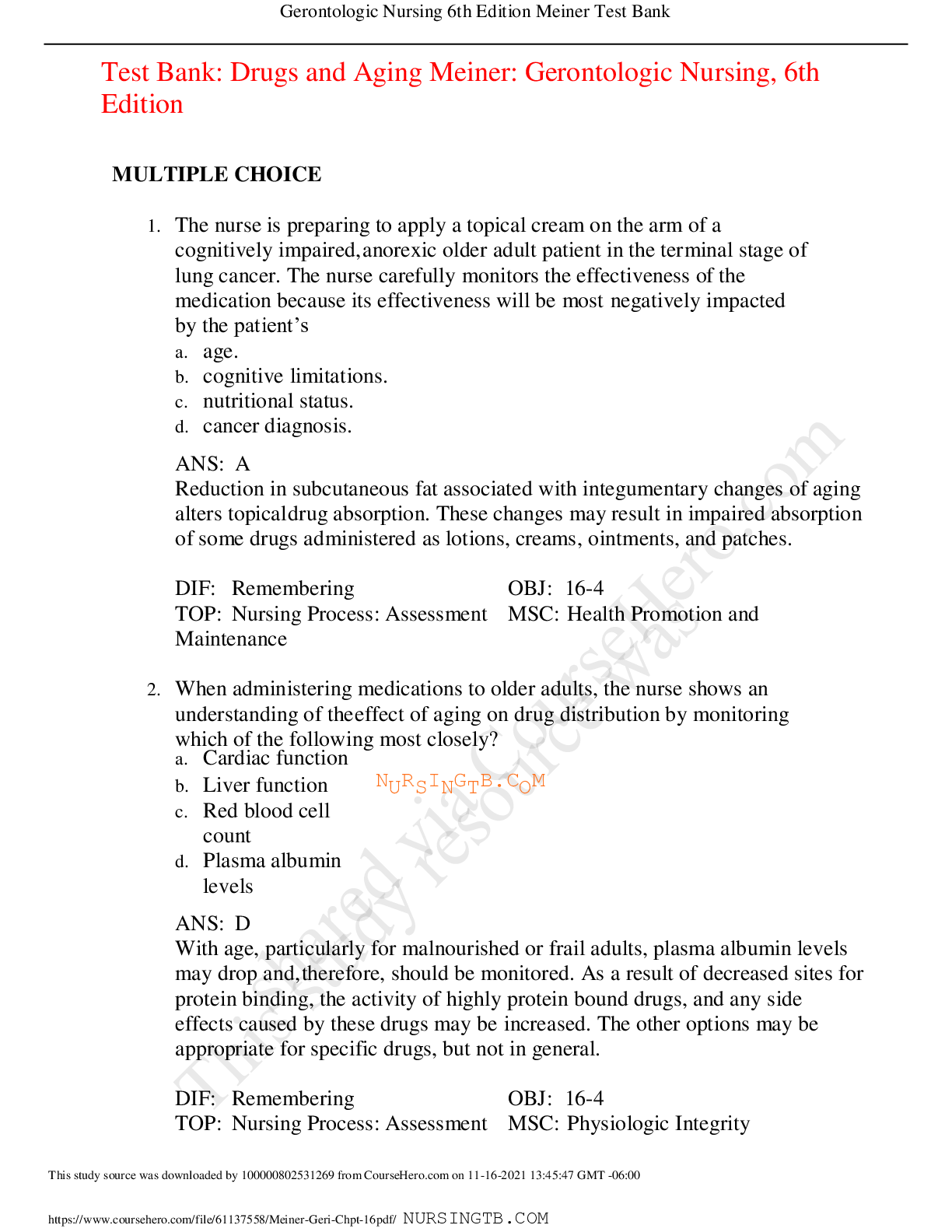
Buy this document to get the full access instantly
Instant Download Access after purchase
Add to cartInstant download
Reviews( 0 )
Document information
Connected school, study & course
About the document
Uploaded On
Nov 21, 2021
Number of pages
15
Written in
Additional information
This document has been written for:
Uploaded
Nov 21, 2021
Downloads
0
Views
41

